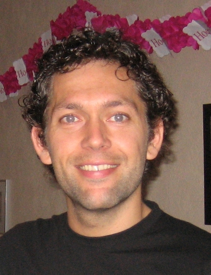New Ligands for Americium: a Combinatorial Approach
Promotion date: 16 May 2007
| Americium is a metal like uranium, but man-made. It does not occur in nature. Imagine the waste product of the nuclear energy industry like a very hot highly toxic soup comprising different elements, a large part of it uranium that has not been used and plutonium that is a result of the nuclear reaction. For thirty to fifty years it has to cool down and after that about 99% of he uranium and the plutonium can be extracted. About 10 % of the substance that remains is still very radioactive and harmful, containing Neptunium, Americium and Curium. |
I worked on Americium.
Small quantities of Americium can either be packed in a stable rock formation or, the other option, be bombed with neutrons, thus changing the material properties. If you want to do that, the Americium needs to be fairly pure and not contaminated with other elements.
I had to find the ligands that selectively extract the Americium. playing a kind of molecular Packman.
Did you succeed?
I developed a nice new method to speed up the existing process for finding new Americium ligands. It is based on an efficient combination of combinatorial synthesis and screening that has never been used before. An example of an approach is parallel synthesis, which is nothing but doing a lot of reactions at the same time. The advantage is that this process can be automated. But we used a split pool method which is considerably more efficient when having an appropriate screening method. We proved that our approach is fast and efficient by the synthesis of many ligands, a few of which are relatively good.
Important work.
Yes, and more so since nuclear energy is becoming an option again in our battle to reduce CO2. More funds are made available for this kind of research, although it never completely disappeared from the scientific agenda. In the US, in Hanford, a lot of nuclear waste is stored in steel barrels and these barrels are leaking now. So whether you continue with nuclear energy or not, research into toxic waste has to continue.
Will your method be used?
I don’t know yet. More work has to be done, more funds are needed and you never know how long it takes before the money is available.
Was the research dangerous for yourself?
I had to go to Petten for performing the extraction and screening experiments, There, at the Nuclear Research and Consultancy Group, they have a specially equipped laboratory for work on these elements. I had to follow a theoretical course and a hands-on training to be able to work safely. But I worked with very low concentrations of Americium. You can even detect nanograms of it.
Did you enjoy your research?
I had my ups and downs. In the beginning you have to find your footing. Of course you have a supervisor who makes suggestions, but you have to find your own approach. Sometimes your ideas don’t work and you have to find something else. That is a time consuming business.
My first two years did not yield many results.
But on the whole is was very enjoyable, I made many different friends of all nationalities.
Our group is a very international and multidisciplinary one.
What are your plans?
I am doing a postdoc at the MnF Group of Professor Jurriaan Huskens at the moment. My plan is to continue with a postdoc abroad, preferably Australia.

